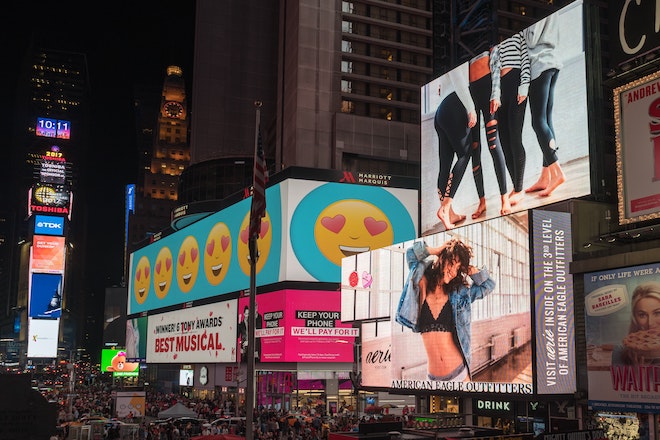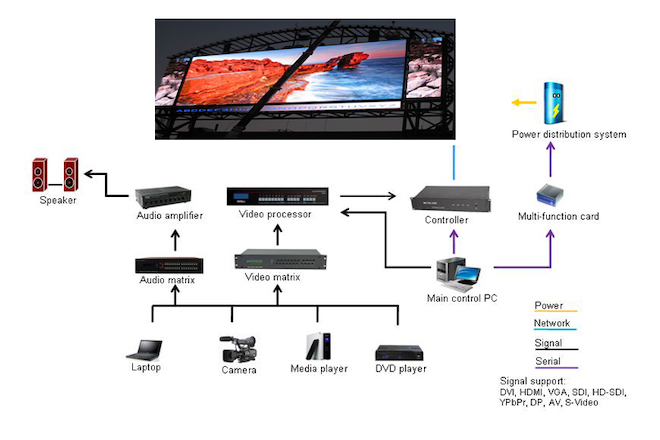What is an LED display?
What are the classifications of LED screens?
What are the structures & components of led displays?
How does a led display work?
What are the technical characteristics of the LED display?
What are the common application scenarios of LED displays?

1. What is an LED display?
LED Display (Light Emitting Diode Display) is a screen display technology that uses an LED as the light source; it displays various information devices such as text, images, video, etc.
Because of its bright colors, wide dynamic range, high brightness, long life, stable and reliable operation, etc. is widely used in commercial media, theatrical performance market, stadiums, information releases, news releases, securities trading, etc. LED displays adapt to the needs of different environments.
2. What are the structures & components of led displays?
LED display screens to include led display cabinets, power supplies, Control System, and LED modules.
Each LED module includes a diode, driver IC and PCB board. The LED panels are connected to form a connected LED display.
LED Display Cabinets: Most LED displays usually use a series of LED display cabinets, which are combined to form the entire LED display screen, LED cabinets make LED screen manufacturing and shipping easier.
LED Power Supplies: Components convert and regulate grid voltage to power other electronic components.
Control system: The main function of the LED display control system is to make the LED display the signal source screen through the signal transmission between the sending card and the receiving card.
LED modules: An LED panel or LED module for LED screens is a small circuit that integrates LEDs and other necessary electronics so that the LEDs can reproduce images and videos.
PCB board: Specifically made for LED circuits
Connection: It can be divided into data, transmission, and power lines.
Data cable: The cable used to connect the control card and the LED unit board.
Transmission line: The user’s main function is to connect the control card and the computer.
Power cable: used to connect power and control card and LED unit board.
Dedicated high graphics card and multi-function card: It has the basic functions of the computer graphics card and can output RGB digital signal.
Other sources of information and equipment: include computers, televisions, Blu-ray Discs, DVDs, VCDs, camcorders, and VCRs.
3. What are the classifications of LED screens?
1) According to application scenarios: indoor and outdoor, semi-outdoor
2) Divided by display screen color:
Single-color LED display: a single color, such as: red, green, blue, etc.
Dual primary color LED display: with red and green as double primary colors, 256-level grayscale, it can display 65,536 colors.
Full-color LED display: It can display more than 16 million colors with red, green, and blue, three primary colors, and a 256-level grayscale full-color display.
3) According to the display performance: text screen, graphic screen, synchronous video screen, TV video communication screen, market LED screen, etc.
4. How Does a led display work?

5. What are the technical characteristics of the LED display?
- Good display effect: led screen using dynamic scanning technology, the picture is stable, without noise, the image effect is clear, and the video effect is smooth.
- Display rich content: The lesson displays text, pictures, animations, videos, etc.
- Flexible way: users can arrange and display arbitrarily
- A large amount of information: The displayed information is not limited.
- Easy maintenance: Modular design, easy installation, and easy maintenance.
6. What is the common application of LED displays?
What are the different types of LED displays, and what scenarios are they used in?
According to the characteristics, uses, and forms of LED displays, LED displays are mainly divided into advertising LED displays, sports LED displays, stage displays, fine pitch displays, poster LED displays, and creative LED displays.
Generally speaking, LED displays can bring commercial value and information display through advertising. Commercial LED displays are divided into indoor and outdoor types; common LED displays in daily life.
- Application scenarios:
shopping malls, commercial buildings, large billboards on roads, shops, indoor cinemas, churches, banks, airports, gas stations, etc.
Generally used in events and live games, there are 6 types of sports LED screens: broadcast display, information LED display, fence screen, four-sided LED screen, scoreboard LED display, and creative LED display.
- Main application scenarios:
a series of sports game competition scenarios such as outdoor football/basketball stadiums, ice rinks, swimming pools, horse racing, racing cars, and video game competitions.
The LED display for stage activities, the stage LED display is mainly: indoor fixed LED display, rental LED display.
- Main application scenarios:
large and small concerts, fashion shows, various types of exhibition halls, churches, award ceremonies, graduation ceremonies, speech forums, various stage events, etc.
4) Small Pixel Pitch LED Display
The display effect picture is more delicate and high-definition, and it is more comfortable to watch. It is generally used indoors.
- Main application scenarios:
high-end conference rooms, military control rooms, TV live broadcast rooms, home theaters, etc.
Most of the poster screens are placed at the store entrance and are displayed as poster advertisements. The screens can be spliced and used individually, and the operation is fast to place advertisements, and they are mostly used indoors.
- Main application fields:
coffee shops, cake shops, clothing stores, restaurants, hotels, electronic product stores, etc.
Its soft, bendable properties can be spliced into different shapes. The screen is more of a visual and artistic design, highly malleable and impressive.
- Main application scenarios:
stage design, shopping mall sign display, museums, exhibitions, Internet celebrity building, etc.
Conclusion:
The above is the analysis of the types, structures, characteristics, and application scenarios of LED displays; We hope to help you.
BIBILED display products have a wide range of products, which can meet the needs of advertising, holding events, art exhibitions, live broadcasts, conference training, cultural promotion, etc.
If you want to know or buy an LED display, please email info@bibiled.com or leave a comment below.
We provide you with customized and satisfactory LED display solutions and provide high-quality services throughout the entire process, seeking guidance or other help for you to purchase products.
